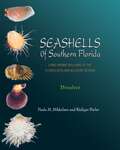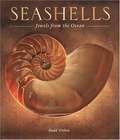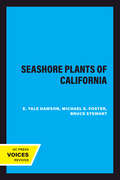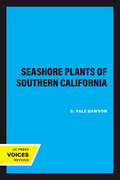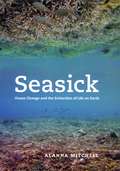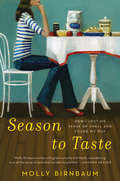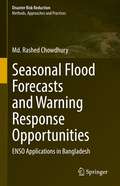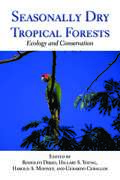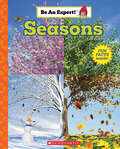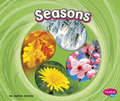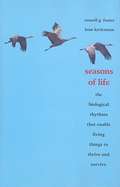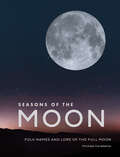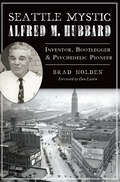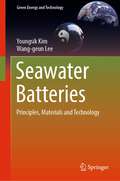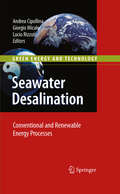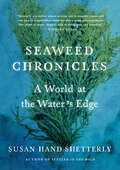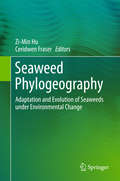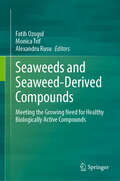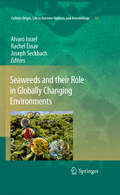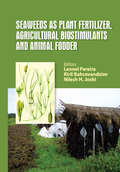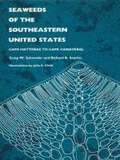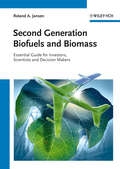- Table View
- List View
Seashells of Southern Florida: Living Marine Mollusks of the Florida Keys and Adjacent Regions: Bivalves
by Paula M. Mikkelsen Rüdiger BielerLocated where the Atlantic Ocean, Gulf of Mexico, and Caribbean Sea converge, the Florida Keys are distinctive for their rich and varied marine fauna. The Keys are home to nearly sixty taxonomic families of bivalves such as clams and mussels--roughly half the world's bivalve family diversity. The first in a series of three volumes on the molluscan fauna of the Keys and adjacent regions, Seashells of Southern Florida: Bivalves provides a comprehensive treatment of these bivalves, and also serves as a comparative anatomical guide to bivalve diversity worldwide. Paula Mikkelsen and Rüdiger Bieler cover more than three hundred species of bivalves, including clams, scallops, oysters, mussels, shipworms, jewel boxes, tellins, and many lesser-known groups. For each family they select an exemplar species and illustrate its shell and anatomical features in detail. They describe habitat and other relevant information, and accompany each species account with high-resolution shell photographs of other family members. Text and images combine to present species--to family-level characteristics in a complete way never before seen. The book includes fifteen hundred mostly color photographs and images of shells, underwater habitats, bivalves in situ, original anatomical and hinge drawings, scanning electron micrographs, and unique transparent--shell illustrations with major organ systems color-coded and clearly shown. Seashells of Southern Florida: Bivalves is the most complete guide to subtropical bivalves available. It is an essential tool for students and teachers of molluscan diversity and systematics, and an indispensable identification guide for collectors, scuba divers, naturalists, environmental consultants, and natural-resource managers.
Seashells: Jewels from the Ocean
by Budd TitlowThey have done time as jewelry and tools, as medicines, currency, and symbols of industry--and they have intrigued people, from beach-combing toddlers to serious scientists, since time began. Native interest meets natural history in this exquisitely illustrated account of the science and culture of seashells. With closeup photography and basic explanations of different shell types--univalves, bivalves, and cephalopods--how they are formed, what mollusks inhabit them, their morphology and life cycles, and much more, this is the book for anyone with an interest in seashells. This book includes information on the bewildering array of shell shapes, colors, sizes, and types, and describes where the different shells can be found throughout the world. As informative as it is visually arresting, the book will appeal to amateur and expert, collector and casual beachcomber. Picture captions included.
Seashells: More Than a Home
by Melissa StewartProlific, award-winning nonfiction author Melissa Stewart reveals the surprising ways seashells provide more than shelter to the mollusks that inhabit them.Young naturalists discover thirteen seashells in this elegant introduction to the remarkable versatility of shells. Dual-layered text highlights how shells provide more than a protective home in this expository nonfiction exploration. The informative secondary text underscores characteristics specific to each shell. Elegant watercolor illustrations create a scrapbook feel, depicting children from around the world observing and sketching seashells across shores.
Seashore Plants of California (California Natural History Guides #47)
by Michael S. Foster E. Yale DawsonThis title is part of UC Press's Voices Revived program, which commemorates University of California Press’s mission to seek out and cultivate the brightest minds and give them voice, reach, and impact. Drawing on a backlist dating to 1893, Voices Revived makes high-quality, peer-reviewed scholarship accessible once again using print-on-demand technology. This title was originally published in 1982.
Seashore Plants of Southern California (California Natural History Guides #19)
by E. Yale DawsonThis title is part of UC Press's Voices Revived program, which commemorates University of California Press’s mission to seek out and cultivate the brightest minds and give them voice, reach, and impact. Drawing on a backlist dating to 1893, Voices Revived makes high-quality, peer-reviewed scholarship accessible once again using print-on-demand technology. This title was originally published in 1966.This title is part of UC Press's Voices Revived program, which commemorates University of California Press’s mission to seek out and cultivate the brightest minds and give them voice, reach, and impact. Drawing on a backlist dating to 1893, Voices Revived</DIV
Seasick: Ocean Change and the Extinction of Life on Earth
by Alanna MitchellIn Seasick, Alanna Mitchell dives beneath the surface of the worlds oceans to give readers a sense of how this watery realm can be managed and preserved, and with it life on earth.
Season to Taste: How I Lost My Sense of Smell and Found My Way
by Molly Birnbaum“A rich, engrossing, and deeply intelligent story….This is a book I won’t soon forget.”—Molly Wizenberg, bestselling author of A Homemade Life“Fresh, smart, and consistently surprising. If this beautifully written book were a smell, it would be a crisp green apple.”—Claire Dederer, bestselling author of PoserSeason to Taste is an aspiring chef’s moving account of finding her way—in the kitchen and beyond—after a tragic accident destroys her sense of smell. Molly Birnbaum’s remarkable story—written with the good cheer and great charm of popular food writers Laurie Colwin and Ruth Reichl—is destined to stand alongside Julie Powell’s Julie and Julia as a classic tale of a cooking life. Season to Taste is sad, funny, joyous, and inspiring.
Seasonal Flood Forecasts and Warning Response Opportunities: ENSO Applications in Bangladesh (Disaster Risk Reduction)
by Md. Rashed ChowdhuryThis book explores the feasibility of using El Niño-Southern Oscillation (ENSO)-based forecasts and early warning systems to prevent losses from floods and droughts in Bangladesh. Despite advances in short-range flood forecasting and information dissemination systems in Bangladesh, the present system is less than satisfactory. This is due to short lead-time products, outdated dissemination networks, and lack of direct feedback from the end-user. One viable solution is to produce long-lead seasonal forecasts—the demand for which is significantly increasing in Bangladesh— and disseminate these products through appropriate channels. As observed in other regions, the success of seasonal forecasts, in contrast to short-term forecasts, depends on consensus among the participating institutions. Therefore, the primary objective of the book is to revisit and modify the framework of an ideal warning response system for issuance of consensus seasonal flood forecasts in Bangladesh. The book discusses issues related to the 5-stage Flood Forecasts, Warning, and Response System (FFWRS) and emphasizes the role of the seasonal ‘Climate Outlook Forum (COF)’ in Bangladesh. The book also identifies ways to improve forecasting and early warning systems by utilizing ENSO-based climate data and models, and discusses a comprehensive and participatory approach to seasonal flood hazard management in Bangladesh.Several successful case examples of ENSO-based seasonal forecasts and early warning systems from other ENSO-sensitive regions have been documented. The primary audience includes academics and students, government policymakers, engineers, and business leaders.
Seasonally Dry Tropical Forests: Ecology and Conservation
by Harold A. Mooney Hillary S. Young Gerardo Ceballos Rodolfo DirzoThough seasonally dry tropical forests are equally as important to global biodiversity as tropical rainforests, and are one of the most representative and highly endangered ecosystems in Latin America, knowledge about them remains limited because of the relative paucity of attention paid to them by scientists and researchers and a lack of published information on the subject. Seasonally Dry Tropical Forests seeks to address this shortcoming by bringing together a range of experts in diverse fields including biology, ecology, biogeography, and biogeochemistry, to review, synthesize, and explain the current state of our collective knowledge on the ecology and conservation of seasonally dry tropical forests. The book offers a synthetic and cross-disciplinary review of recent work with an expansive scope, including sections on distribution, diversity, ecosystem function, and human impacts. Throughout, contributors emphasize conservation issues, particularly emerging threats and promising solutions, with key chapters on climate change, fragmentation, restoration, ecosystem services, and sustainable use. Seasonally dry tropical forests are extremely rich in biodiversity, and are seriously threatened. They represent scientific terrain that is poorly explored, and there is an urgent need for increased understanding of the system's basic ecology. Seasonally Dry Tropical Forests represents an important step in bringing together the most current scientific information about this vital ecosystem and disseminating it to the scientific and conservation communities.
Seasons (Be an Expert!)
by Erin KellyKids love to be the experts! Now they can feel like real pros with this exciting nonfiction series for beginning readers. Kids will be hooked on the thrilling real-world topics and big, bright photos. Each book features simple sentences and sight words that children can practice reading. Then, with support, kids can dig deeper into the extra facts, Q&As, and fun challenges.Fans of this series will be eager to become real experts!Some are warm and sunny. Some are cold and wet. There are four different seasons in a year! What do you know about winter, spring, summer, and fall? With this book you can become an expert!
Seasons (Cycles of Nature)
by Jaclyn JaycoxWhat time of year do leaves change color? Why can’t flowers grow in the snow? Track all four seasons and discover the importance of weather patterns to plant and animal life,
Seasons of Life: The biological rhythms that enable living things to thrive and survive
by Russell G. Foster Leon KreitzmanIn this fascinating book, Russell G. Foster and Leon Kreitzman draw on remarkable recent scientific advances to explain how seasonal change affects organisms, and how plants and animals over countless generations have evolved exquisite sensitivities and adaptations to the seasons. The authors also highlight the impact of seasonal change on human health and well-being. They conclude with a discussion of the dangers posed when climate changes disrupt the seasonal rhythms on which so much life depends.
Seasons of the Moon: Folk Names and Lore of the Full Moon
by Michael CarabettaFrom Strawberry to Dragon, Harvest to Storm, the full moon is known by many names around the world and across the seasons, and each name has a story behind it. This beautiful photographic celebration of our closest celestial neighbor captures the visual wonder and the connection we feel to the moon. Including three dozen folk names and short evocative explanations drawn from Native American, Inuit, Celtic, medieval English, Hindu, Chinese, Japanese, and pagan cultures, Seasons of the Moon presents an inspired visual pairing for each, taken in the month the folk name represents. This portrait of our eternal fascination with the moon is a welcome companion as we look to the sky throughout the seasons.
Seattle Mystic Alfred M. Hubbard: Inventor, Bootlegger, & Psychedelic Pioneer
by Brad HoldenThe biography of an intriguing man who came to Seattle as an inventor and went on to become a bootlegger, a spy, and a proponent of LSD.Seattle has a long tradition of being at the forefront of technological innovation. In 1919, a mysterious young inventor named Alfred M. Hubbard made his first newspaper appearance with the announcement of a perpetual motion machine that harnessed energy from Earth&’s atmosphere. From there, Hubbard transformed himself into a charlatan, bootlegger, radio pioneer, top-secret spy, millionaire and uranium entrepreneur. In the early 1950s, after discovering the transformative effects of a little-known hallucinogenic compound, Hubbard would go on to become the &“Johnny Appleseed of LSD,&” paving the way for the very first generation of psychedelic disciples and beyond. Join author and historian Brad Holden as he chronicles the life of one of the most fascinating figures to emerge from Seattle&’s past.&“A captivating history of one of America&’s most colorful characters—Al Hubbard. Holden dives into the larger-than-life history of a man whose past intersects with rum running, spy rings, police informants, and psychedelics. Brilliantly told, Holden brings Hubbard&’s enigmatic character to life.&” —Erika Dyck PhD, Professor at the University of Saskatchewan, and author of Psychedelic Psychiatry: LSD from Clinic to Campus &“An engaging biography about the mysterious Al Hubbard, who helped pioneer psychedelic therapy and is credited by Stan Grof with developing the model of the high dose inner-directed session to catalyze a mystical experience.&” —Rick Doblin, PhD, founder and executive director of the Multidisciplinary Association for Psychedelic Studies (MAPS) &“This is the remarkable story of Captain Al Hubbard—inventor, con man, secret agent, uranium entrepreneur, and indefatigable LSD apostle, who saw the light while high on psychedelics in the early 1950s and never looked back.&” —Martin A. Lee, author of Acid Dreams—The Complete Social History of LSD: The CIA, the Sixties, and Beyond
Seawater Batteries: Principles, Materials and Technology (Green Energy and Technology)
by Youngsik Kim Wang-geun LeeThis book introduces the working principle, materials, and design of seawater batteries and reviews the current state-of-the-art technologies in cells and modules.This book looks at the characteristics of seawater, then reviews the basic electrochemical processes involved in the storage of electrical charge in seawater batteries, and then discusses the development of anode, cathode, and membrane materials, and cell engineering progress. In particular, Chapter 3 contains the latest research and development results for rechargeable seawater batteries. The book has been written for a broad readership including graduate students, academic and industrial researchers working on sustainable, low-cost energy.
Seawater Desalination
by Andrea Cipollina Giorgio Micale Lucio RizzutiA growing proportion of the world's population is dependent on Seawater Desalination as a source of fresh water for both potable and civil use. One of the main drawbacks of conventional desalination technologies is the substantial energy requirement, which is facing cost increases in the global energy market. "Seawater Desalination" presents an overview of conventional and non-conventional technologies, with a particular focus on the coupling of renewable energies with desalination processes. The first section of this book presents, in a technical but reader-friendly way, an overview of currently-used desalination processes, from thermal to membrane processes, highlighting the relevant technical features, advantages and disadvantages, and development potential. It also gives a rapid insight into the economic aspects of fresh water production from seawater. The second section of the book presents novel processes which use Renewable Energies for fresh water production. From the first solar still evaporators, which artificially reproduced the natural cycle of water, technology has progressed to develop complex systems to harness energy from the sun, wind, tides, waves, etc. and then to use this energy to power conventional or novel desalination processes. Most of these processes are still at a preliminary stage of development, but some are already being cited as examples in remote areas, where they are proving to be valuable in solving the problems of water scarcity. A rapid growth in these technologies is foreseen in the coming years. This book provides a unique foundation, within the context of present and future sustainability, for professionals, technicians, managers, and private and public institutions operating in the area of fresh water supply.
Seaweed Biology
by Kai Bischof Christian WienckeSeaweeds, also known as macroalgae, are among the most important primary producers and act as ecological engineers on rocky coasts of the world's oceans. In addition to their extreme ecological importance they are also of high economic relevance. Complementing available textbooks with its more research-oriented approach, this volume contains 22 chapters by renowned experts, grouped in five parts. In Part I fundamental processes and acclimation strategies of seaweeds towards the abiotic environment are covered. Part II focuses on the multitude of biotic interactions in seaweed communities, and in Part III the reader is introduced to the structure and function of the main seaweed systems of the world. The chapters of Part IV highlight and discuss the effects of global and local environmental changes on seaweeds and their communities. In the final Part V a comprehensive overview of developments in seaweed aquaculture, industrial applications and the overall economic importance of seaweeds is provided. Summarizing the advances in seaweed biology achieved within the last few decades, this book also identifies gaps in the present knowledge and needs for future research.
Seaweed Chronicles: A World at the Water's Edge
by Susan Hand Shetterly“You might not expect unfettered passion on the topic of seaweed, but Shetterly is such a great storyteller that you find yourself following along eagerly.” —Mark Kurlansky “Seaweed is ancient and basic, a testament to the tenacious beginnings of life on earth,” writes Susan Hand Shetterly in this elegant, fascinating book. “Why wouldn’t seaweeds be a protean life source for the lives that have evolved since?” On a planet facing environmental change and diminishing natural resources, seaweed is increasingly important as a source of food and as a fundamental part of our global ecosystem. In Seaweed Chronicles, Shetterly takes readers deep into the world of this essential organism by providing an immersive, often poetic look at life on the rugged shores of her beloved Gulf of Maine, where the growth and harvesting of seaweed is becoming a major industry. While examining the life cycle of seaweed and its place in the environment, she tells the stories of the men and women who farm and harvest it—and who are fighting to protect this critical species against forces both natural and man-made. Ideal for readers of such books as The Hidden Life of Trees and How to Read Water, Seaweed Chronicles is a deeply informative look at a little understood and too often unappreciated part of our habitat.
Seaweed Ecology and Physiology
by Catriona L. Hurd Paul J. Harrison Kai Bischof Christopher S. Lobban Catriona L. Hurd Paul J. Harrison Kai BischofA rewritten and re-organised edition of The Physiological Ecology of Seaweeds (1985). Seaweed Ecology and Physiology surveys the broad literature, but it is not merely an update of the earlier book. This new book contains a new introductory chapter reviewing seaweed morphology, cytology, and life histories. The chapter on community level ecology now includes six guest essays by senior algal ecologists which conveys the excitement of phycological research. The treatment of tropical seaweeds had been expanded, reflecting the growing literature from tropical regions, and the authors' recent experiences in the tropics. The final chapter on mariculture is much larger, and includes a case study on how principles of physiological ecology were applied in developing the carrageenan industry. Finally there is an appendix summarising the taxonomic position and nomenclature of the species mentioned in the book.
Seaweed Phylogeography
by Zi-Min Hu Ceridwen FraserThe book provides an overview ofresearch on the remarkable diversity, adaptive genetic differentiation, andevolutionary complexity of intertidal macroalgae species. Through incorporatingmolecular data, ecological niche and model-based phylogeographic inference,this book presents the latest findings and hypotheses on the spatialdistribution and evolution of seaweeds in the context of historical climatechange (e. g. the Quaternary ice ages), contemporary global warming, andincreased anthropogenic influences. The chapters in this book highlight pastand current research on seaweed phylogeography andpredict the future trends and directions. This book frames a number of researchcases to review how biogeographic processes and interactive eco-geneticdynamics shaped the demographic histories of seaweeds, which furthermoreenhances our understanding of speciation and diversification in the sea. Dr. Zi-Min Hu is an associateprofessor at Institute of Oceanology, Chinese Academy of Sciences, Qingdao,China. Dr. Ceridwen Fraser is asenior lecturer at Fenner School of Environment and Society, AustralianNational University, Canberra, Australia.
Seaweeds and Seaweed-Derived Compounds: Meeting the Growing Need for Healthy Biologically Active Compounds
by Fatih Ozogul Monica Trif Alexandru RusuRecent advances in the industrial application and industrial development of seaweeds are important in addressing the world's growing needs for healthy nutrients. Seaweeds are a potentially sustainable feedstock for future food and feed, green chemicals, and fuels. For seaweed biorefinery, the fractionation of the biomass to co-produce multiple products is crucial in the efficient valorization of the aquatic biomass. Widespread use of seaweed is still limited by a number of factors including harvesting access, seasonality and geographical location of algae, toxicological aspects, as well as the availability of scalable production methods. A good example is protein isolation from algae, since current processes of algal protein isolation are time-consuming and economically unviable. Seaweeds and Seaweed-Derived Compounds offers a comprehensive overview of sustainable seaweeds for the recovery of low-cost dietary nutrients from algae and alga-based biomass and their validation to meet market the requirements of consumers and industry in different sectors. With chapters focusing on seaweeds as foods, pharmaceuticals and cosmetic and dermatological applications, this text provides multidisciplinary knowledge of this sustainable biomass presented with a mix of academic and industrial perspectives.
Seaweeds and their Role in Globally Changing Environments
by Rachel Einav Joseph Seckbach Alvaro IsraelGlobal warming is accelerating faster than the ability for natural repair, and environmental stresses are damaging ecosystems, all affecting physical and biological systems on Earth. A new Nasa-led study shows that human activity has caused climate changes resulting in permafrost thawing, acid rain, and lower productivity in lakes as well as increased emissions of greenhouse gases, including CO2, N20, CH4, CF3, and CFC. Marine plants play a vital role in maintaining the balance of marine environments, while serving as a source of food for humankind and important chemical compounds. Microalgae and seaweed have enormous potential for reducing global warming and climate change. During photosynthesis algae grow, draw CO2 from the atmosphere, release oxygen, and produce solar biofuel. Experts in the life of marine plant ecosystems in globally changing environments contributed chapters to this book. The target readers are phycologists, ecologists, atmospheric scholars, conservationists, environmentalists, and ecologically aware laymen.
Seaweeds as Plant Fertilizer, Agricultural Biostimulants and Animal Fodder
by Leonel Pereira Kiril Bahcevandziev Nilesh H. JoshiThe main effects of Seaweed extracts (Ascophyllum, Fucus, Sargassum, Saccorhiza, Laminaria, Gelidium and others), when used as agricultural fertilizers, are better seed germination and higher quality fruit production, with longer shelf life; better use of soil nutrients; more productive crops and plants with greater resistance to unfavorable environmental conditions. Algae also have a long history of use as animal feed. They have a highly variable composition depending on the species, collection season and habitat, and on external conditions such as water temperature, light intensity and nutrient concentration in water. In relation to ruminal fermentation, a high variability of the digestibility values was found among seaweed species and cannot be attributed only to the composition of different nutrients of the algae. The role of marine algae for reduction of methane production is discussed with particular emphasis on novel algae-based feed strategies that target minimal methane emissions without affecting the functionality of the microbiota and overall animal productivity. Key Features: Sustainable Agriculture Natural Feeding Nutrients Liquid Seaweed Agricultural Biostimulants Natural Pesticides
Seaweeds of the Southeastern United States: Cape Hatteras to Cape Canaveral
by Craig W. Schneider Richard B. SearlesSeaweeds of the Southeastern United States offers a definitive manual for the identification of the seaweeds that inhabit the deep offshore waters as well as the near shoreline and shallow sounds from North Carolina to Florida. The volume provides a natural key to the class, order, family, and genera with detailed descriptions, 560 illustrations, and an artificial key listing simple characteristics for quick identification of the green, brown, and red benthic marine algae (or "bottom growers") that inhabit the region.The southeastern Atlantic coast is home to 334 species of seaweed flora. The greatest diversity occurs along the North Carolina coast between Cape Lookout and Cape Fear. With the exception of a few additional species south of Cape Fear, there is not a marked change in the flora until the more tropical waters and seaweeds of southern Florida. The barrier island system of the region and the enclosed shallow water sounds extend the miles of shoreline available for study.This book, the product of a twenty-year collaboration, is the first comprehensive guide to appear in over seventy years and includes the addition of nearly one hundred species to the region, including twenty-five described by the authors.
Second Generation Biofuels and Biomass
by Roland A. JansenThis guide to investing in the bioenergy market covers the topic from both a scientific, economic and political perspective. It describes the increasing number of second generation biodiesel projects which are now emerging in anticipation of growing sustainability concerns by governments, and in response to market demands for improved process efficiencies and greater feedstock production yields. The book also closely examines the science and technology involved in second generation biofuels and gives concrete examples, such as in the aviation industry. The result is an essential guide for scientists, investors, politicians and decision-makers in the energy sector.
